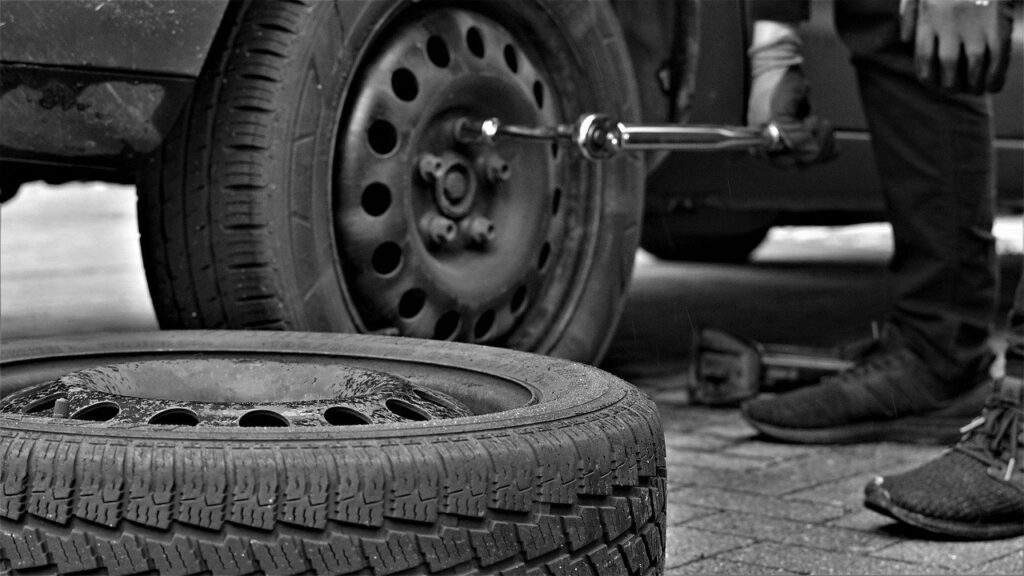Summer tires versus winter tires
At the very beginning, it is worth knowing the differences between summer and winter tires. Based on this knowledge, you can deduce the best time to change.
Summer tires are characterized as flat, which ensures the best grip. Keep in mind that rubber is the only thing that is in direct contact with the ground surface.
Summer tires do not generate too much noise and maintain good driving characteristics even on a wet surface. However, its most important feature is resistance to high temperatures. It must be remembered that in the summer months asphalt can heat up to several dozen degrees Celsius. This could cause the rubber to melt. That is why summer tires stand out with additional protection against high temperatures. Unfortunately, this comes at the expense of frost resistance. Low temperature causes summer tire to get thick and thus lose its good grip. As a result, it may skid more easily and lose control of the vehicle.
That is why winter tires are essential. They are made of soft rubber that does not harden due to low temperatures. The material is enriched with various types of additives that ensure flexibility. Winter tires are cut with sipes, which on the one hand are necessary to achieve proper grip despite unfavorable conditions, and on the other hand, affects energy efficiency. Unfortunately, tires intended for the colder months increase car fuel consumption. However, you can’t abandon winter tires without endangering yourself and other road users.

When to replace summer tires with winter tires?
Timely tire replacement is a matter of safety. Therefore, you shouldn’t delay buying new tires until the last minute. On the other hand, swapping too early may result in a reduction in some of the service life. This is the greatest fear of all drivers. After all, tires are not rough to the cheapest elements of cars, and tire wear entails an additional cost.
It is necessary at this point that using winter tires in too high temperature really have an impact on the quality of the tires. It’s a fact. However, it is also true that the damage is very subtle, in most cases imperceptible. It is difficult to talk about a serious shortening of tire life. So don’t worry if you change your tires 2-3 weeks before the season.
When is the time for winter tires?
Talking about a specific date does not make much sense, especially now, in the era of rapidly advancing climate change. The outside temperature is of the greatest importance. Experts recognize that winter tires should be swapped when the average daily temperature no longer exceeds 7ºC. Of course, you have to take into account the variability of the weather. It can often be 5ºC one day and above 10ºC the next. So a lot of people wait for the weather conditions to stabilize. This is not a bad tactic and many experts recommend it. However, changing tires the moment the temperature drops for the first time is not a bad idea. It is possible to predict with high probability that the first frosts will appear soon.
It should be emphasized that you should not wait until the first snow or frost. Then it is too late. Not only that driving may then be a real danger, but also the summer tires are getting damaged. It is enough to carefully observe the weather forecast to prepare in advance for the replacement.
When to go back to summer tires? The best moment is when the temperatures are already above the aforementioned 7ºC. Similarly to the winter period, you have to make the correction for changing weather. The stabilized temperature obliges to swap the tires, so you can start saving on fuel faster.

Is it profitable to change tires yourself?
Most drivers still use a vulcanizer to replace their winter tires with their summer tires and vice versa. For some time, however, the opposite trend has been observed. More and more vehicle owners prefer to change tires themselves. Why? This is mainly due to easy access to professional tools at an attractive price. Thanks to a one-time investment, you can save on a visit to a vulcanization workshop twice a year. Besides, it is very rewarding to change the tires yourself!
Recommended car garage are tools for are Aircom brand tire mobility kit sets. The manufacturer offers everything that is necessary for a professional inflate and quick repair of the tire. Thanks to this, you can get high-quality equipment in one place that will serve you for many seasons. Replacing a regular vulcanizer visit with a self-replacement moment is a good idea for those who enjoy working on their car.
To what you should pay attention to when swapping tires yourself?
Changing from winter to summer tires (and vice versa) is quite simple. However, you should follow a few rules and remember important details. Here they are:
1. Pressure. Information about how high it should be can be found on the side of the tire. Manufacturers cite a value that ensures a comfortable and safe ride. It is not worth exceeding it. Otherwise, the tires may be damaged. On the other hand, too low pressure will cause difficulties while driving. A compressor is used to achieve the correct pressure.
2. Age of tires. Heavily worn-out tires are not suitable for further use. So if a lot of seasons have passed, we should consider buying new ones. The date of manufacture of the tire is shown on the sidewall.
3. Balancing. Poor balance causes uneven wear of the tire and reduces overall driving comfort (vibrations of the steering wheel, body, etc.). A balancer is required for adjustment.
4. Wheel alignment. Wheels not folded at the right angle increase fuel consumption and accelerate tire wear. It is best to place them in parallel. Thanks to this, you gain good stability and good driving dynamics. Parallel alignment is considered a compromise between operating speed and performance.
5. Tread. This is the best indicator of tire wear. If it is too small, it is better not to change tires yourself and buy new tires. Specialists recommend measuring the tread depth quite regularly, even when using the services of a vulcanizer. As a result, you can react in time to the deteriorating condition of your tires.

How much time you need to reserve for tire changes?
In the case of vulcanization workshops, we always talk about fast work performed by experienced mechanics. How long does it take to change tires with a vulcanizer? Usually, it is 15-20 minutes. However, this can be extended up to an hour if the tires need to be dismounted from the rims and are low profile with fairly large size. Of course, the delay also applies to any unforeseen factors, such as the need to replace damaged components.
How long does it take to change tires on your own? It all depends on your own skills and practice. If you have professional equipment, the work should not take much longer than in the case of a workshop. Using someone else’s help will also have a positive effect on reducing the replacement time. However, the independent change should not take longer than 30 minutes, and in extreme cases up to an hour





